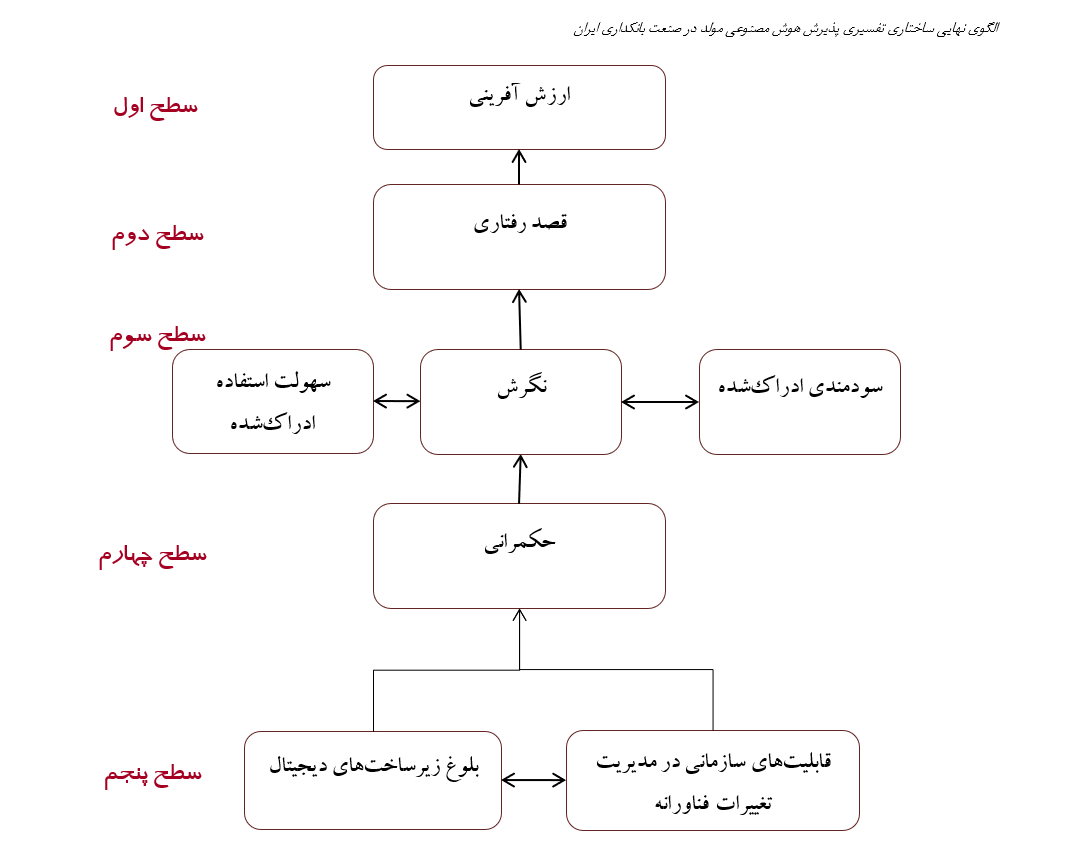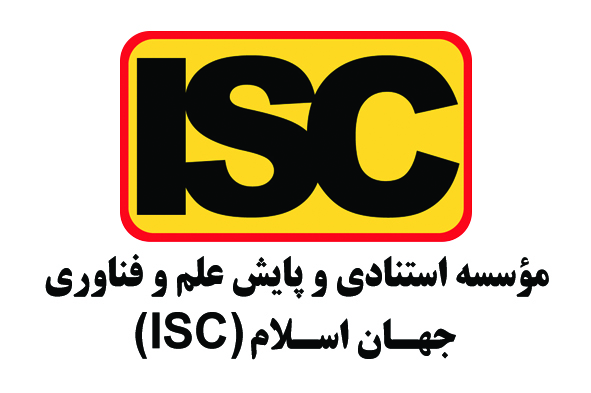طراحی الگوی پذیرش هوش مصنوعی مولد در صنعت بانکداری ایران
کلمات کلیدی:
پذیرش هوش مصنوعی مولد, صنعت بانکداری ایران, تحلیل مضمون, مدلسازی ساختاری- تفسیریچکیده
هدف پژوهش، طراحی الگوی پذیرش هوش مصنوعی مولد در صنعت بانکداری ایران با رویکرد تحلیل مضمون و مدلسازی ساختاری–تفسیری است. این پژوهش از نظر هدف، کاربردی و از نظر روششناسی، آمیخته اکتشافی (کیفی–کمی) است. در بخش کیفی، دادهها از طریق مصاحبههای نیمهساختاریافته با 13 نفر از خبرگان حوزههای مدیریت، فناوری اطلاعات و بانکداری جمعآوری و با روش تحلیل مضمون تحلیل شدند. در بخش کمی از پرسشنامه مدلسازی ساختاری تفسیری (ISM) برای سطحبندی مضامین استفاده شد. دادهها با نرمافزار Micmac تحلیل گردیدند. مشارکتکنندگان بهصورت هدفمند و تا رسیدن به مرحله اشباع انتخاب شدند. نتایج تحلیل مضمون نشان داد 81 مضمون پایه در قالب 20 مضمون سازماندهنده و 8 مضمون فراگیر شناسایی شدند که شامل بلوغ زیرساختهای دیجیتال، قابلیتهای سازمانی در مدیریت تغییرات فناورانه، حکمرانی، ارزشآفرینی، قصد رفتاری، سهولت استفاده ادراکشده، سودمندی ادراکشده و نگرش بودند. در تحلیل ساختاری–تفسیری، بلوغ زیرساختهای دیجیتال و قابلیتهای سازمانی در مدیریت تغییرات فناورانه در پایینترین سطح و ارزشآفرینی در بالاترین سطح مدل قرار گرفتند. متغیرهای میانی شامل حکمرانی، سهولت استفاده، سودمندی، نگرش و قصد رفتاری بهعنوان پیونددهنده سطوح مختلف شناسایی شدند. پذیرش موفق هوش مصنوعی مولد در بانکداری ایران مستلزم تعامل مؤلفههای فنی، سازمانی و انسانی است. بلوغ زیرساختهای دیجیتال، حکمرانی اثربخش و نگرش مثبت کاربران زمینهساز ایجاد ارزشآفرینی و مزیت رقابتی پایدار در نظام بانکداری خواهند بود.
دانلودها
مراجع
Aghamohammadi, H., & Enayati Hatke Loui, H. (2024). Identifying human capital challenges in Banking 4.0 influenced by artificial intelligence advancements: A meta-synthesis study. Strategic Financial and Banking Studies, 2(2), 98–114. https://www.journal-fbs.com/article_201217.html
Bai, X., Zhuang, S., Xie, H., & Guo, L. (2024). Leveraging generative artificial intelligence for financial market trading data management and prediction. Preprints. https://doi.org/10.20944/preprints202407.0084.v1
Balaji, K. (2024). Harnessing AI for Financial Innovations: Pioneering the Future of Financial Services. In Modern Management Science Practices in the Age of AI (pp. 91–122). IGI Global. https://doi.org/10.4018/979-8-3693-6720-9.ch004
Botunac, I., Parlov, N., & Bosna, J. (2024). Opportunities of Gen AI in the Banking Industry with regards to the AI Act, GDPR, Data Act and DORA.
Chakraborty, U., Roy, S., & Kumar, S. (2023). Rise of Generative AI and ChatGPT: Understand how Generative AI and ChatGPT are transforming and reshaping the business world. BPB Publications.
Gallego-Gomez, C., & De-Pablos-Heredero, C. (2020). Artificial intelligence as an enabling tool for the development of dynamic capabilities in the banking industry. International Journal of Enterprise Information Systems (IJEIS), 16(3), 20–33. https://doi.org/10.4018/IJEIS.2020070102
Gupta, V., & Yang, H. (2024). Generative artificial intelligence (AI) technology adoption model for entrepreneur: Case of ChatGPT. https://doi.org/10.1080/10875301.2023.2300114
Kate, P., Ravi, V., & Gangwar, A. (2022). Fingan: Generative adversarial network for analytical customer relationship management in banking and insurance. arXiv preprint arXiv:2201.11486. https://doi.org/10.1007/s00521-022-07968-x
Kate, P., Ravi, V., & Gangwar, A. (2023). FinGAN: Chaotic generative adversarial network for analytical customer relationship management in banking and insurance. Neural Computing and Applications, 35(8), 6015–6028. https://doi.org/10.1007/s00521-022-07968-x
Kheradmmandnia, S., & Taghizadeh, M. (2024). Generative artificial intelligence: Challenges and requirements for development and implementation. https://report.mrc.ir/article_10243.html
Kshetri, N., Dwivedi, Y. K., Davenport, T. H., & Panteli, N. (2024). Generative artificial intelligence in marketing: Applications, opportunities, challenges, and research agenda. International Journal of Information Management, 75. https://doi.org/10.1016/j.ijinfomgt.2023.102716
Liu, S., Li, G., & Xia, H. (2021). Analysis of Talent Management in the Artificial Intelligence Era. https://doi.org/10.2991/aebmr.k.210218.007
Mahida, A. (2023). Explainable Generative Models in FinCrime. Journal of Artificial Intelligence, Machine Learning & Data Science, 1(2), 205–208. https://doi.org/10.51219/JAIMLD/ankur-mahida/69
Mahmoudi Meymand, M., & Mohseni Fard, N. (2024). The effect of generative artificial intelligence adoption on organizational performance in small and medium-sized enterprises. Journal of New Research Approaches in Management and Accounting, 8(28), 2449–2463. https://majournal.ir/index.php/ma/article/view/2662
Mousavi, S. R., & Abedian Azarkhvarani, N. (2023). The impact of artificial intelligence and metaverse innovations on modern banking. Journal of New Research Approaches in Management and Accounting, 7(26), 1389–1405. https://majournal.ir/index.php/ma/article/view/2197
Nasr Esfahani, M., Ghaemi Asl, M., Montazer, R., & Esmaeili, M. (2025). The role of artificial intelligence enabling capabilities in enhancing supervisory performance of Iran's banking system. Country Studies, 3(4), 713–753. https://doi.org/10.22059/jcountst.2025.388154.1218
Nazarpour, M., Nasl Mousavi, S. H., & Hosseini Shirvani, M. S. (2020). Application of artificial intelligence in tax auditing. Auditing Knowledge, 20(81), 198–226. https://sid.ir/paper/967020/fa
Ooi, K. B., Tan, G. W. H., Al-Emran, M., Al-Sharafi, M. A., Capatina, A., Chakraborty, A., & Wong, L. W. (2023). The potential of generative artificial intelligence across disciplines: Perspectives and future directions. Journal of Computer Information Systems, 1–32. https://doi.org/10.1080/08874417.2023.2261010
Paramesha, M., Rane, N. L., & Rane, J. (2024). Artificial intelligence, machine learning, deep learning, and blockchain in financial and banking services: A comprehensive review. Partners Universal Multidisciplinary Research Journal, 1(2), 51–67. https://doi.org/10.2139/ssrn.4855893
Patil, D., Rane, N. L., & Rane, J. (2024). Acceptance of ChatGPT and generative artificial intelligence in several business sectors: Key factors, challenges, and implementation strategies. In. https://doi.org/10.70593/978-81-981367-8-7_5
Rahman, M., Ming, T. H., Baigh, T. A., & Sarker, M. (2023). Adoption of artificial intelligence in banking services: an empirical analysis. International Journal of Emerging Markets, 18(10), 4270–4300. https://doi.org/10.1108/IJOEM-06-2020-0724
Rane, J., Kaya, Ö., Mallick, S. K., & Rane, N. L. (2024). Generative Artificial Intelligence in Agriculture, Education, and Business. Deep Science Publishing. https://doi.org/10.70593/978-81-981271-7-4
Rodrigues, A. R. D., Ferreira, F. A., Teixeira, F. J., & Zopounidis, C. (2022). Artificial intelligence, digital transformation and cybersecurity in the banking sector: A multi-stakeholder cognition-driven framework. Research in International Business and Finance, 60, 101616. https://doi.org/10.1016/j.ribaf.2022.101616
Saghafi, A., & Parsapour, M. R. (2025). Investigating the impact of accounting data analysis using generative artificial intelligence on the quality of digital sustainability reporting considering the mediating role of green sustainability internal control systems. Financial Accounting Knowledge, 12(1), 1–31. https://doi.org/10.30479/jfak.2025.21533.3270
Samala, A. D., Rawas, S., Wang, T., Reed, J. M., Kim, J., Howard, N. J., & Ertz, M. (2024). Unveiling the landscape of generative artificial intelligence in education: a comprehensive taxonomy of applications, challenges, and future prospects. Education and Information Technologies, 1–40. https://doi.org/10.1007/s10639-024-12936-0
Thamma, S. R. (2024). An Experimental Analysis of Revolutionizing Banking and Healthcare with Generative AI. https://philarchive.org/archive/THAAEA-3
Tong, H. H., & Lim, M. (2024). The Potential for Artificial Intelligence to Address Challenges Faced by Custodian Banks. https://doi.org/10.69554/IODC6478
Vucinic, M., & Luburic, R. (2024). Artificial Intelligence, Fintech and Challenges to Central Banks. Journal of Central Banking Theory and Practice. https://doi.org/10.2478/jcbtp-2024-0021

دانلود
چاپ شده
ارسال
بازنگری
پذیرش
شماره
نوع مقاله
مجوز
حق نشر 2025 Roohollah Joghtaie, Majid Nasiri, Elahe Masoumi (Author)

این پروژه تحت مجوز بین المللی Creative Commons Attribution-NonCommercial 4.0 می باشد.










